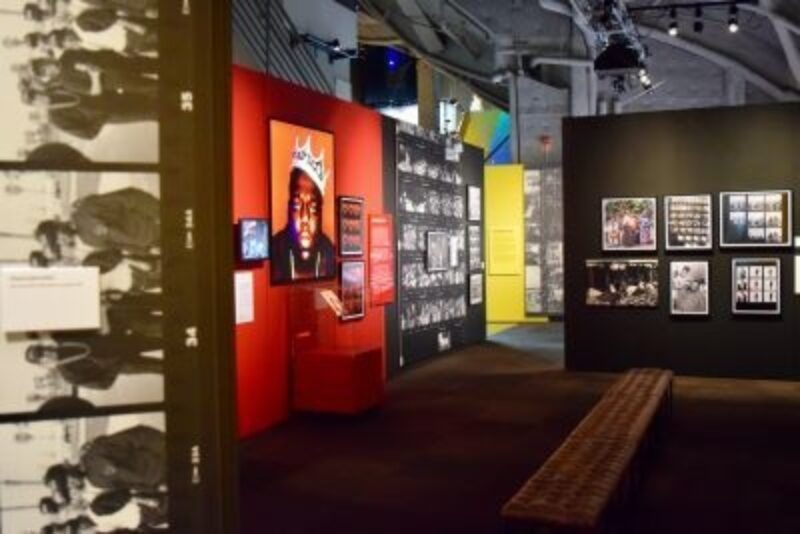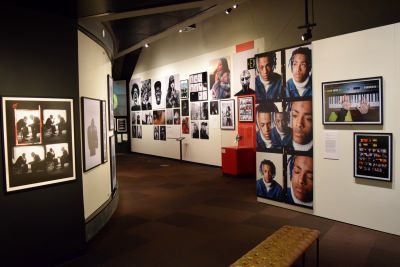Contact High: Intimate Looks at some of the Most Iconic Photographs in Hip-Hop
Review of Contact High: A Visual History of Hip-Hop at MoPOP
Written by Teen Writer Ruby Lee and edited by Teen Editor Esha Potharaju

MoPOP, formerly known as The EMP, has always been the epicenter for all things pop culture, art, and music in Seattle and is constantly showcasing art in innovative ways. Contact High: A Visual History of Hip-Hop is no exception. This exhibit features four decades of hip-hop through film and digital photography, giving visitors a chance to know what photos didn’t make it onto classic album covers and magazine spreads while overall celebrating the culture and craft that is hip-hop.
Rickey Powell’s work welcomes me at the entrance, a magnificent glowing wall with some of Powell’s original slides from the 80s and 90s. Seeing familiar faces like rapper Chuck D of Public Enemy and TV host Oprah excited me for the work ahead. Throughout the first space of the exhibit, contact sheets (a preview of all the images on the roll of film), framed prints, and magazine spreads tell magnificent stories. It was at this moment that I understood “visual history” to be a completely accurate description of the exhibition.
Another wall shows a contact sheet marked in pen. Photographers often make notes about the images they liked, ones they didn't, or any other thoughts directly on the sheet. These markings, whether that be an X over the photo, a circle, or a little note on the side, remind the viewer how exquisitely individual and unique they are to the artist. To tie it all together, a framed print hangs in the middle of the wall showing the photo that was eventually picked. I absolutely adore this detail because it shows two sides of the story, one we can relate to and one that is new. This particular photo, one taken by Al Pereira of rappers Tupac, Redman, and a young Nas, amazed the crowd because it depicted Nas during a time when he was not yet the icon he is today. He was but an up and coming rapper and simply happened to be in the photo. Stories like these, of shots that give context in unexpected ways, were some of my favorites throughout the exhibit.
As I enter the next section, something catches my eye. You’d think it would be the crisp black suit worn by New York’s The Notorious B.I.G. (Biggie). Or maybe the influential MC Rakim’s Dapper Dan jacket from the album cover of Follow the Leader. Instead, it’s prints of Rap R&B artists Erykah Badu and Lauryn Hill. I let out a gasp and walk swiftly over to the corner where they hang, gawking at their powerful presence. This is what I think all viewers experience in one part or another: Seeing prints across the room that they simply have to run to before seeing anything else.

Towards the end of the walk, there’s a screening of the 25-minute Contact High documentary. This was the crème de la crème. Suddenly, the pictures scattered throughout the exhibit were finally pieced together into a story told from the perspective of the photographers themselves. During the documentary, photographer Barron Clairborne said that his iconic King of New York portrait of Biggie was a portrayal of how he saw him, as a king. The contact sheet for this shoot shows slightly different versions of the mean mug Biggie gives in the final image. My attention, however, is directed towards a completely different photo of Biggie. He's laughing. Seeing the photo made me realize the world had rarely seen a photo of Biggie smiling. However, Barron expressed that this was Biggie to people who knew him, that he had been joking around throughout the shoot. I had just learned something, saw something, that would change the way I saw the original image. How incredibly special.
The prints that follow are large and tower over the exhibit. Artists like Tyler, the Creator, MF DOOM, and Frank Ocean hang above me. Similar to Biggie, these artists helped expand my love of hip-hop into unique sub genres. I loved this blend of new and old, nostalgia, and the excitement of new talent. More than that, I loved knowing that collectively, we were all feeling giddy and amazed. Knowing we all had special connections to these images.
As I make my way toward the exit of the exhibit I think, what a huge privilege it is to be walking through a museum featuring Black men and women. We have accustomed ourselves to knowing art and museums in a Eurocentric sense and up until more recently, with artists like Kehinde Wiley and Jacob Lawrence, we’ve had a lack of Black art on the center stage. Contact High is full of so much love for the Black pioneers of hip-hop; it’s a breath of fresh air and an important experience for everyone to have.
Contact High opened on October 16, 2021, and is currently at MoPOP. For more information see here.
Lead photo credit courtesy of MoPOP
The TeenTix Newsroom is a group of teen writers led by the Teen Editorial Staff. For each review, Newsroom writers work individually with a teen editor to polish their writing for publication. The Teen Editorial Staff is made up of 6 teens who curate the review portion of the TeenTix blog. More information about the Teen Editorial Staff can be found HERE.
The TeenTix Press Corps promotes critical thinking, communication, and information literacy through criticism and journalism practice for teens. For more information about the Press Corps program see HERE.


